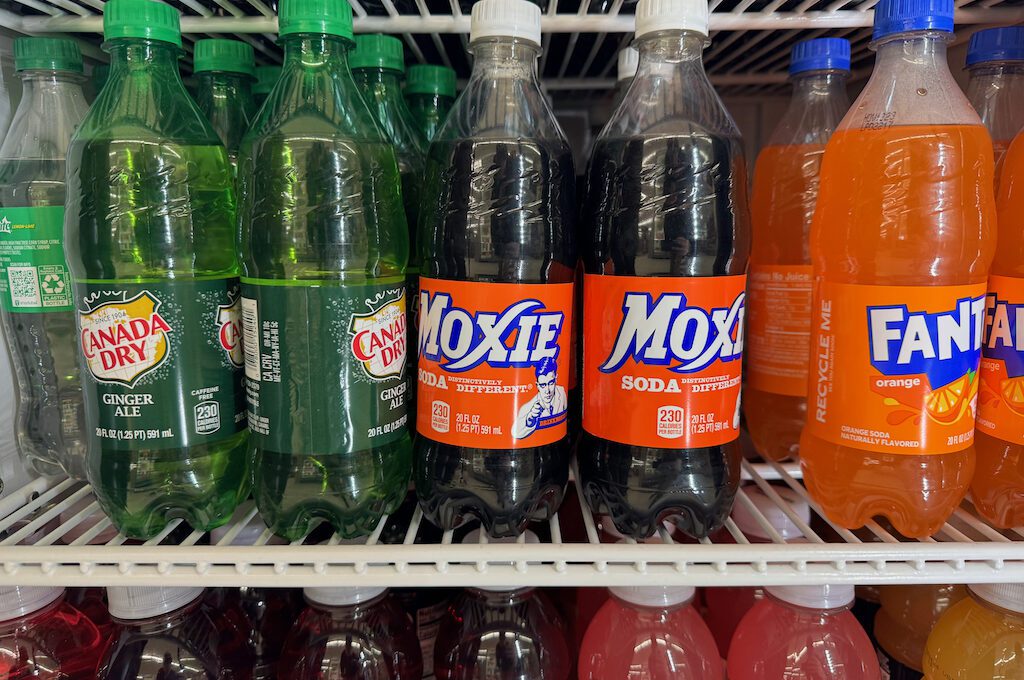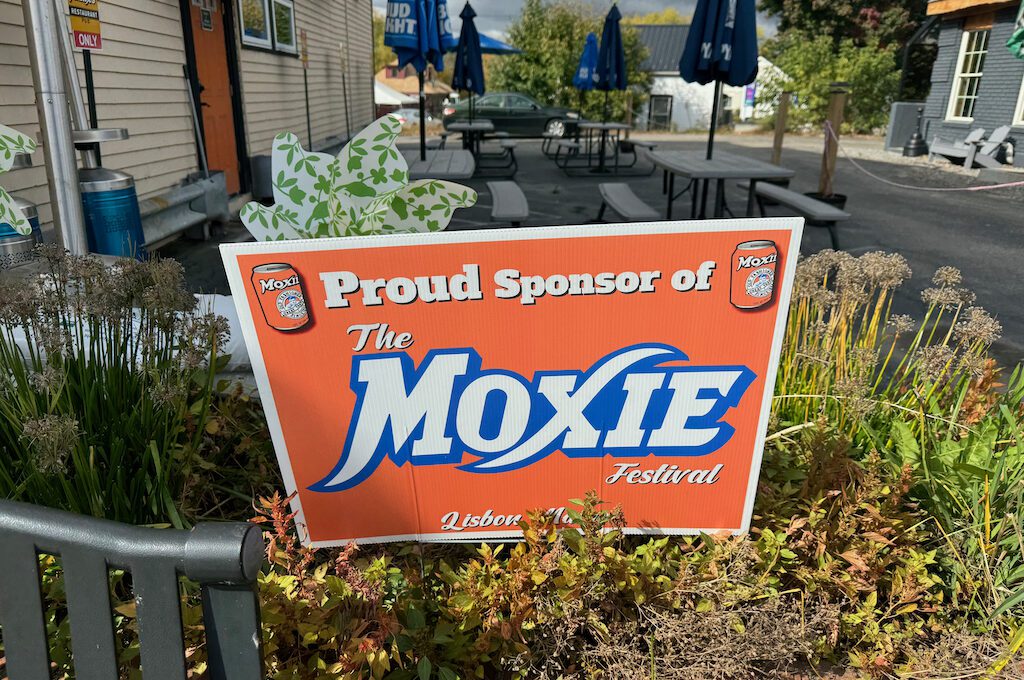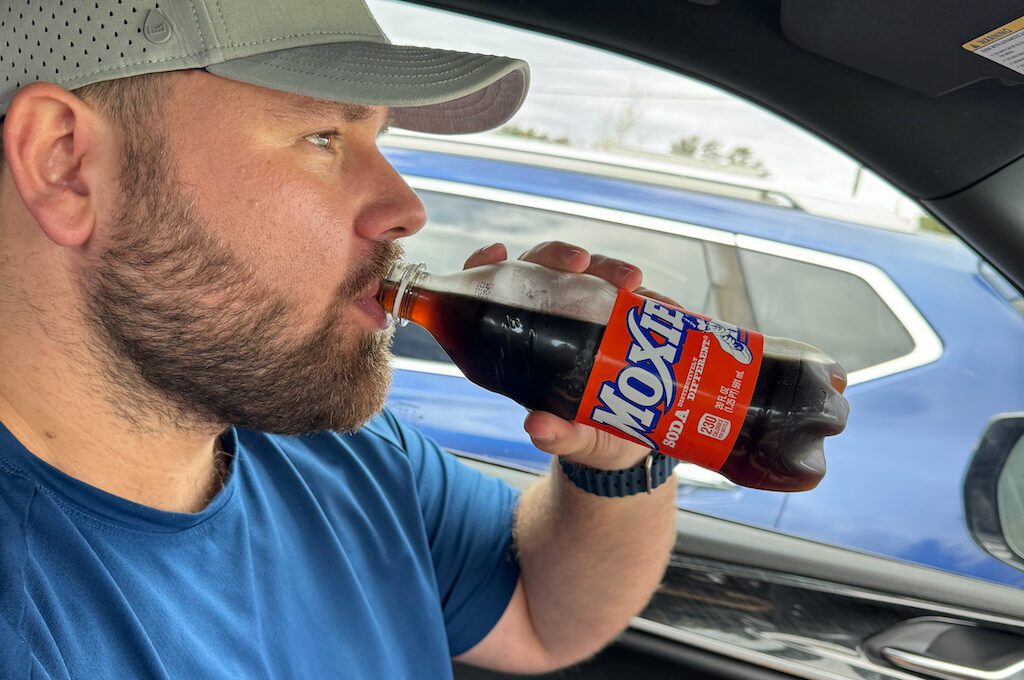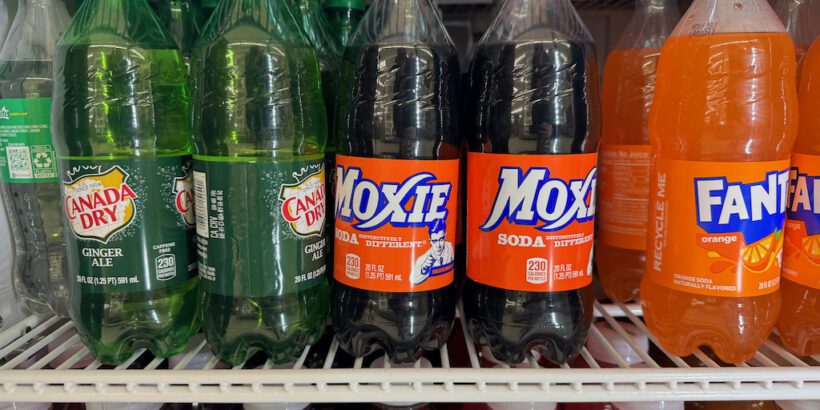Exploring the local culinary scene while traveling never fails to pique my interest.
Be it unearthing the charm of a Boston Cooler, indulging in pasties, or savoring the uniqueness of cudighi, I’m perpetually on the lookout for regional delights steeped in interesting history.
So when I came across Moxie when planning out a trip to Maine, I knew this iconic beverage would have to be explored.
Below, I’ll walk you through some of that interesting history with Moxie and also give you some tips on how to find it as well as how to immerse yourself in it should you feel so inclined!
What is Moxie?
Moxie is one of the oldest soft drinks in the United States and is the official soft drink of the State of Maine.
This cola, with its intriguing blend of flavors akin to a slightly medicinal root beer, has stood the test of time and become a regional favorite. Mostly found in the charming corners of New England, especially in Maine, Moxie is not just a drink; it’s a taste of history and a sip of local pride.

A brief history of Moxie
Augustin Thompson, a former Civil War hero turned visionary alchemist, is the mastermind behind the creation of Moxie.
In an era when medicinal elixirs sometimes included rather potent ingredients like cocaine, Thompson set out to craft a libation that was gentler on the palate and the constitution.
In 1876, he secured a patent for a potent concoction featuring the gentian root, a distinctive ingredient for the drink that has been used in tonics dating back to at least 170 BC.
This laid the foundation for what would eventually emerge as a medicinal syrup in 1884. Thompson’s innovative approach not only offered a safer alternative but also birthed a legendary beverage that would leave a lasting mark on American culture.
In 1885, Thompson secured a trademark for the term “Moxie,” introduced carbonation, and unveiled it to the public as a beverage produced in Lowell, Massachusetts.
It’s not 100% clear where Thompson’s true inspiration for the term Moxie came from with some speculating that he just made it up and others attributing it to Native American terms for local rivers or lakes.
The exact debut year of Moxie also remains a subject of debate, with some proponents advocating for 1884 and others 1885.
What’s indisputable, however, is that Moxie holds its ground as one of the oldest soft drinks in the United States, predating Coca-Cola, regardless of the specific timeline you choose.
Thanks to Thompson’s sterling reputation as a proficient holistic doctor, he could tout a slew of health advantages for his concoction.
Moxie was cleverly promoted as a nerve tonic, promising to rejuvenate those weary souls worn out either mentally or physically. Its curative claims stretched from remedying “loss of manhood” to alleviating paralysis and even addressing the enigmatic condition of “softening of the brain.”
As Moxie’s popularity soared, Dr. Thompson decided to bid adieu to his medical practice in 1886 and devote his undivided attention to his burgeoning Moxie Nerve Food enterprise.
Thompson, and later his son who assumed the role of president, didn’t hold back when it came to advertising Moxie. They went all in, plastering the beverage’s presence across numerous newspapers, often in various languages to cater to the diverse immigrant population.
These ads were brimming with remarkable tales of recovery and tales of health transformations, serving as wild testaments to the healing powers of Moxie.
In 1903, a mere three years after Thompson’s passing, the emergence of the Food and Drug Administration (FDA) prompted Moxie to dial down its extravagant claims of being a panacea. Consequently, it shifted its promotional focus from being a “nerve tonic” or “nerve food” to rebrand itself as a simple “soft drink.”
Nevertheless, the Moxie marketing juggernaut continued to exert its formidable influence, proving that even regulatory adjustments couldn’t rein in the brand’s unwavering charisma.
In the roaring 1920s, Moxie managed to outshine its formidable rival, Coca-Cola, thanks in large part to the ingenious efforts of their marketing maestro, Frank Archer.
Archer had a knack for crafting catchy taglines and ensuring Moxie’s name was front and center in the public eye. The brand rolled out a series of memorable slogans, including the ever-popular “Make it Moxie for Mine.”
Moxie became synonymous with qualities like spunk, pep, courage, and the fortitude to “build up your nerve.” And just in case you were curious, the very word “Moxie” found its origins in this iconic soft drink.
Frank Archer’s flair for taglines was just the tip of the iceberg.
He orchestrated an official Moxie song (video) that hit all the right notes, setting the stage for a parade of high-profile celebrity endorsements. Among the illustrious names were baseball legends like Ted Williams and Babe Ruth, not to mention President Calvin Coolidge, who reportedly toasted his inauguration with a refreshing swig of Moxie.
But, of course, there was that one time when Moxie went a tad overboard by delivering an unauthorized endorsement to the rugged President Teddy Roosevelt. The brand was swiftly compelled to issue a retraction. Yet when you think about it, it’s all part of the spirited, unapologetic essence that defines having Moxie, isn’t it?
Moxie was no stranger to the world of gimmick marketing, and one of its most famous stunts was the Moxie Horsemobile.
This creation featured a faux horse perched on top of a vehicle, with someone daringly steering the contraption from their equine perch.
These Moxie Horsemobiles embarked on cross-country journeys, becoming star attractions at parades, public celebrations, and practically any gathering where Moxie was up for grabs. If you’re ever in Lincoln, New Hampshire, you can still catch a glimpse of one of these iconic vehicles on display at Clark’s Trading Post.

Another brilliant move in their marketing playbook involved the colossal 32-foot high Moxie bottle, a towering spectacle that made its presence felt at fairs and amusement parks. Visitors were invited to step inside this mammoth bottle, ascend to a window with a view, and then gleefully descend back to ground level via an exterior slide.
Perhaps the most iconic and enduring gimmick of them all was the “Moxie Boy.”
This charismatic character made his grand entrance in 1906, striking a pose that echoes the famous “I Want You” Uncle Sam Army posters. Intriguingly, some even suggest that Uncle Sam himself may have drawn inspiration from the Moxie Boy.
Believed to be John T. Chamberlain hailing from Revere, Massachusetts, the Moxie Boy swiftly ascended to become one of the most universally recognized promotional figures in history. To this day, you can still spot the Moxie Boy gracing the classic orange cans and bottle packaging, a testament to his enduring presence in the brand’s legacy.

Over the years, Moxie’s once-skyrocketing popularity gradually waned, eventually settling into its role as a beloved regional gem, cherished by many in the northeastern United States.
In 2018, Coca-Cola acquired Moxie though following the trail of subsidiaries and corporate connections is a bit of a mental whirlwind.
Where to find Moxie today
If you’re on the hunt for Moxie, you’ll have a few good leads to follow.
Your first stop might be those charming old-school candy shop and soda fountain establishments, where you’re likely to uncover this vintage gem. Cracker Barrels throughout the Northeast and Midwest are another candidate.
However, if you’re looking for the quintessential Moxie experience, it’s no secret that Maine, the official home turf of this unique beverage, is the place to be. That’s where you’re most likely to hit the Moxie motherlode and savor it in all its authentic glory.

In the great state of Maine, you’ll discover Moxie served up in a variety of settings. Popular restaurants, especially those renowned for their scrumptious lobster rolls, often feature Moxie on the menu or in their chilled drink coolers.
Even your local ice cream parlor might surprise you with Moxie-infused delights, like Moxie floats, and if you’re exceptionally fortunate, you might even stumble upon the elusive Moxie-flavored ice cream.
However, be warned that Moxie can sometimes play hard to get, which can make your quest for it a tad challenging. In such instances, you might come up short at convenience stores and have to make a beeline for markets or select grocery stores to secure your Moxie fix. Sometimes the thrill of the hunt is all part of the Moxie adventure.

One dependable spot to snag cans and bottles of Moxie is the Food City in Lisbon, Maine. And if you’re in Lisbon, don’t forget to explore the ice cream shop conveniently situated across from the store, where you might just stumble upon a scoop of Moxie-infused ice cream.

Lisbon holds a special place in the heart of Moxie enthusiasts, as it’s the epicenter of the annual Moxie festival, where an array of Moxie products are up for grabs during the month of July. Everything from a Moxie chugging contest to a Moxie whoopie pie eating contest goes down over the span of three days.
And while you’re in town, make a pit stop at Frank’s Restaurant, where the Moxie influence runs deep, and they’re sure to serve up this iconic drink.

For those eager to delve deeper into Moxie’s storied history, a pilgrimage to Union, Maine is in order. Here, you’ll find the Matthews Museum of Maine Heritage, which houses an entire wing dedicated to Moxie artifacts. It’s a treasure trove for Moxie aficionados, although it’s worth noting that they typically close down for the late fall/winter, so plan your visit accordingly.
So what does Moxie taste like?
The flavor of Moxie has undergone a transformation over the years, partly due to evolving regulations that necessitated the removal of ingredients like sassafras. This means that if someone sampled it way back in the day, the taste might differ somewhat from what we experience today.
Our tasting adventure led us to sample Moxie from both cans and bottles, and we quizzed some locals about their take on Moxie’s flavor. Since caffeine isn’t my cup of tea, I took only a modest flavor sample, while my partner, Brad, sipped on a couple of bottles to truly deconstruct the taste.
Our combined consensus placed Moxie’s flavor somewhere in the territory between Coke and root beer, with a quirky hint of medicinal notes that left a distinctively bitter aftertaste.
Conversations with fellow tasters yielded similar (and polarized) opinions – you either love it or not. At the end of the day, the best way to understand why it’s dubbed “distinctively different” is to take a sip and form your own verdict.
Tip: The glass bottles (made by Orca) have real cane sugar versus the other Coke versions which use high fructose corn syrup.

Final word
Moxie certainly stirs up a lot of passion, both for those who adore it and those who might not find it to their taste. However, no matter where your taste buds fall on the Moxie spectrum, it’s hard to deny the enduring allure of this special drink. Few beverages can claim such an indelible impact on our language and boast such an iconic marketing legacy.
Daniel Gillaspia is the Founder of UponArriving.com and the credit card app, WalletFlo. He is a former attorney turned travel expert covering destinations along with TSA, airline, and hotel policies. Since 2014, his content has been featured in publications such as National Geographic, Smithsonian Magazine, and CNBC. Read my bio.


